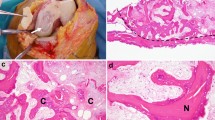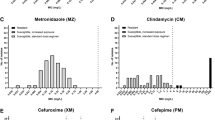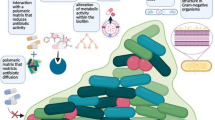Abstract
Fungal osteoarticular infections, including prosthetic joint infections and osteomyelitis, are rare yet present a therapeutic challenge with no guidelines to direct optimal treatment. When these infections occur, the majority are due to Candida species. In addition to systemic therapy, adjunctive antifungal-loaded bone cement has been utilized to successfully treat these infections. Amphotericin B is used most commonly, but cases utilizing voriconazole, fluconazole, and itraconazole have been reported as well. In vitro data suggest better elution of voriconazole from bone cement while there is minimal elution of amphotericin B. Unfortunately, a lack of consistency in the methods of both in vitro studies and case reports makes it difficult to determine if the addition of an antifungal agent in bone cement improves outcomes in fungal osteoarticular infections. This article provides an overview of bone cement as a delivery system for antifungal agents in vitro and in clinical reports.
Similar content being viewed by others
References
Papers of particular interest, published recently, have been highlighted as: • Of importance •• Of major importance
Kurtz S, Ong K, Lau E, Mowat F, Halpern M. Projections of primary and revision hip and knee arthroplasty in the United States from 2005 to 2030. J Bone Joint Surg Am. 2007;89(4):780–5.
Tande AJ, Patel R. Prosthetic joint infection. Clin Microbiol Rev. 2014;27(2):302–45.
Azzam K, Parvizi J, Jungkind D, Hanssen A, Fehring T, Springer B, et al. Microbiological, clinical, and surgical features of fungal prosthetic joint infections: a multi-institutional experience. J Bone Joint Surg Am. 2009;91 Suppl 6:142–9.
Pappas PG, Kauffman CA, Andes D, Benjamin DK, Calandra TF, Edwards JE, et al. Clinical practice guidelines for the management of candidiasis: 2009 update by the Infectious Diseases Society of America. Clin Infect Dis. 2009;48(5):503–35.
Wang QJ, Shen H, Zhang XL, Jiang Y, Wang Q, Chen YS, et al. Staged reimplantation for the treatment of fungal peri-prosthetic joint infection following primary total knee arthroplasty. Orthop Traumatol Surg Res. 2015;101(2):151–6. Largest case series published in which every patient was treated with the same antifungal-loaded bone cement spacer methods.
Kuiper JW, van den Bekerom MP, van der Stappen J, Nolte PA, Colen S. 2-Stage revision recommended for treatment of fungal hip and knee prosthetic joint infections. Acta Orthop. 2013;84(6):517–23.
Karr JC, Lauretta J. In vitro activity of calcium sulfate and hydroxyapatite antifungal disks loaded with amphotericin B or voriconazole in consideration for adjunctive osteomyelitis management. J Am Podiatr Med Assoc. 2015;105(2):104–10. In vitro exploration of voriconazole or amphotericin B released from a biodegradable bone cement.
Sealy PI, Nguyen C, Tucci M, Benghuzzi H, Cleary JD. Delivery of antifungal agents using bioactive and nonbioactive bone cements. Ann Pharmacother. 2009;43(10):1606–15.
Buranapanitkit B, Oungbho K, Ingviya N. The efficacy of hydroxyapatite composite impregnated with amphotericin B. Clin Orthop Relat Res. 2005;437:236–41.
Silverberg D, Kodali P, Dipersio J, Acus R, Askew M. In vitro analysis of antifungal impregnated polymethylmethacrylate bone cement. Clin Orthop Relat Res. 2002;403:228–31.
Grimsrud C, Raven R, Fothergill AW, Kim HT. The in vitro elution characteristics of antifungal-loaded PMMA bone cement and calcium sulfate bone substitute. Orthopedics. 2011;34(8):e378–381.
Goss B, Lutton C, Weinrauch P, Jabur M, Gillett G, Crawford R. Elution and mechanical properties of antifungal bone cement. J Arthroplasty. 2007;22(6):902–8.
Cunningham B, McLaren AC, Pauken C, McLemore R. Liposomal formulation increases local delivery of amphotericin from bone cement: a pilot study. Clin Orthop Relat Res. 2012;470(10):2671–6.
Kweon C, McLaren AC, Leon C, McLemore R. Amphotericin B delivery from bone cement increases with porosity but strength decreases. Clin Orthop Relat Res. 2011;469(11):3002–7.
Miller RB, McLaren AC, Pauken C, Clarke HD, McLemore R. Voriconazole is delivered from antifungal-loaded bone cement. Clin Orthop Relat Res. 2013;471(1):195–200.
Marra F, Robbins GM, Masri BA, Duncan C, Wasan KM, Kwong EH, et al. Amphotericin B-loaded bone cement to treat osteomyelitis caused by Candida albicans. Can J Surg. 2001;44(5):383–6.
Cui Q, Mihalko WM, Shields JS, Ries M, Saleh KJ. Antibiotic-impregnated cement spacers for the treatment of infection associated with total hip or knee arthroplasty. J Bone Joint Surg Am. 2007;89:871–82.
Rouse MS, Heijink A, Steckelberg JM, Patel R. Are anidulafungin or voriconazole released from polymethylmethacrylate in vitro? Clin Orthop Relat Res. 2011;469(5):1466–9.
Ueng SW, Lee CY, Hu CC, Hsieh PH, Chang Y. What is the success of treatment of hip and knee candidal periprosthetic joint infection? Clin Orthop Relat Res. 2013;471(9):3002–9.
Phelan DM, Osmon DR, Keating MR, Hanssen AD. Delayed reimplantation arthroplasty for candidal prosthetic joint infection: a report of 4 cases and review of the literature. Clin Infect Dis. 2002;34(7):930–8.
Skedros JG, Keenan KE, Updike WS, Oliver MR. Failed reverse total shoulder arthroplasty caused by recurrent Candida glabrata infection with prior Serratia marcescens coinfection. Case Rep Infect Dis. 2014;2014:142428.
Denes E, Fiorenza F, Saint-Marcoux F, Megherbi M, Dupon M, Weinbreck P. Voriconazole stability in cement spacers. Med Mal Infect. 2012;42(11):567–8. Determined hip aspirate voriconazole concentrations.
Gaston G, Ogden J. Candida glabrata periprosthetic infection: a case report and literature review. J Arthroplasty. 2004;19(7):927–30.
Selmon GP, Slater RN, Shepperd JA, Wright EP. Successful 1-stage exchange total knee arthroplasty for fungal infection. J Arthroplasty. 1998;13(1):114–5.
Deelstra JJ, Neut D, Jutte PC. Successful treatment of Candida albicans-infected total hip prosthesis with staged procedure using an antifungal-loaded cement spacer. J Arthroplasty. 2013;28(2):374.e375–378. Determined drain and serum concentrations achieved when antifungal-loaded bone cement was utilized in clinical practice.
Wu MH, Hsu KY. Candidal arthritis in revision knee arthroplasty successfully treated with sequential parenteral-oral fluconazole and amphotericin B-loaded cement spacer. Knee Surg Sports Traumatol Arthrosc. 2011;19(2):273–6.
Bruce AS, Kerry RM, Norman P, Stockley I. Fluconazole-impregnated beads in the management of fungal infection of prosthetic joints. J Bone Joint Surg (Br). 2001;83(2):183–4.
Reddy KJ, Shah JD, Kale RV, Reddy TJ. Fungal prosthetic joint infection after total knee arthroplasty. Indian J Orthop. 2013;47(5):526–9.
Zhu ES, Thompson GR, Kreulen C, Giza E. Amphotericin B-impregnated bone cement to treat refractory coccidioidal osteomyelitis. Antimicrob Agents Chemother. 2013;57(12):6341–3. One of few case reports of non-Candida infection treated with antifungal-loaded bone cement and only one to test bone concentrations of amphotericin B.
Gottesman-Yekutieli T, Shwartz O, Edelman A, Hendel D, Dan M. Pseudallescheria boydii infection of a prosthetic hip joint—an uncommon infection in a rare location. Am J Med Sci. 2011;342(3):250–3.
Harmsen S, McLaren AC, Pauken C, McLemore R. Amphotericin B is cytotoxic at locally delivered concentrations. Clin Orthop Relat Res. 2011;469(11):3016–21.
Roberts J, Bingham J, McLaren AC, McLemore R. Liposomal formulation decreases toxicity of amphotericin B in vitro and in vivo. Clin Orthop Relat Res. 2015;473(7):2262–9. Evaluated the safety in vitro and in vivo.
Author information
Authors and Affiliations
Corresponding author
Ethics declarations
Conflict of Interest
The authors declare that they have no competing interests.
Human and Animal Rights and Informed Consent
This article does not contain any studies with human or animal subjects performed by any of the authors.
Additional information
This article is part of the Topical Collection on Pharmacology and Pharmacodynamics of Antifungal Agents
Rights and permissions
About this article
Cite this article
Percival, K.M., Brock, J.T. & Peterson, N.D. Delivery of Antifungal Agents from Bone Cement. Curr Fungal Infect Rep 10, 30–36 (2016). https://doi.org/10.1007/s12281-016-0251-8
Published:
Issue Date:
DOI: https://doi.org/10.1007/s12281-016-0251-8




